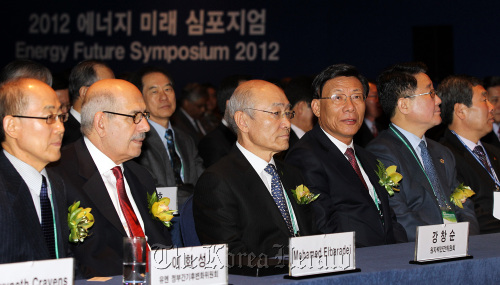Korean reactor models demonstrate upgraded safety features
The Seoul Nuclear Security Summit on March 26 and 27, which will be preceded by a nuclear industry conference three days earlier, is expected to be an opportunity to show off the technological excellence and safety of Korean atomic power plants.
The Korean standard nuclear power plant, which is 95 percent technologically self-sufficient, has risen as a major export item in the country after semiconductors, cars, mobile phones and ships.

Starting with the Kori atomic power station in 1971, Korea now runs 21 nuclear power generation units in Wolsong, Uljin and Yeonggwang.
The country meets 31.1 percent of its electricity demand with nuclear power.
Korea plans to raise the portion to 59 percent by building seven more units by 2016 and up to 12 more by 2030.
Despite the heightened safety concerns after Japan’s nuclear power plant was crippled by a tsunami a year ago, the Seoul government is sticking to its nuclear power policy mainly because it sees it as the most economically efficient source of energy.
Fuel costs account for only about 10 percent of the nuclear power generation cost, whereas they take up more than half of the cost for power generation using petroleum, coal and natural gas.
The Seoul Nuclear Security Summit on March 26 and 27, which will be preceded by a nuclear industry conference three days earlier, is expected to be an opportunity to show off the technological excellence and safety of Korean atomic power plants.
The Korean standard nuclear power plant, which is 95 percent technologically self-sufficient, has risen as a major export item in the country after semiconductors, cars, mobile phones and ships.

Starting with the Kori atomic power station in 1971, Korea now runs 21 nuclear power generation units in Wolsong, Uljin and Yeonggwang.
The country meets 31.1 percent of its electricity demand with nuclear power.
Korea plans to raise the portion to 59 percent by building seven more units by 2016 and up to 12 more by 2030.
Despite the heightened safety concerns after Japan’s nuclear power plant was crippled by a tsunami a year ago, the Seoul government is sticking to its nuclear power policy mainly because it sees it as the most economically efficient source of energy.
Fuel costs account for only about 10 percent of the nuclear power generation cost, whereas they take up more than half of the cost for power generation using petroleum, coal and natural gas.

Uranium, the key material for nuclear power generation, is found in many countries such as Australia, Canada and South Africa, which are politically and economically much more stable than petroleum producing nations in the Middle East.
Also, nuclear power generation barely produces any carbon dioxide.
And Korean atomic power stations are built strong enough to withstand 6.5-magnitude earthquakes and peak ground acceleration of up to 0.2 g.
Starting with the Shin-Kori nuclear power units No. 3 and 4 that are currently under construction, the standards will be raised to a magnitude of 6.9 and 0.3 g.
The Nuclear Safety and Security Commission and the Korea Hydro and Nuclear Power Corp., the group responsible for the operation of the nuclear power plants, are establishing a safety system to deal with various possible situations such as the shut down of the plant due to an electricity cutoff and the emergency power generator breakdown.
They are also applying technologies to prevent radioactive materials from leaking even when earthquakes and tsunamis of an unexpected scale occur.
The NSSC plans to invest 1.1 trillion by 2015 to make safety improvements.
A system that automatically stops the nuclear reactor when an earthquake of over 0.18g is detected has already been installed in the Kori 4, Yeonggwang 2, Wolsong 4, and Uljin 2, 4 and 5 units. It will be installed in other nuclear power plants by November next year.
A system that removes the hydrogen without using electricity to prevent hydrogen explosions is also being placed and the seawalls around the Kori 1 unit, which is on lower ground compared to other units, are being raised to 10 meters.
All nuclear power stations will have waterproof doors and waterproof drainage pumps in case of flooding, and movable emergency power generators will be placed.
The APR1400 light-water nuclear reactor that Korea exported to the United Arab Emirates is a third-generation reactor that has significantly higher resistance to accidents and upgraded safety features.
For example, the APR1400’s reactor vessel is specially designed so that when the fuel rods in the reactor melt down, as happened at the Fukushima plant, they cannot leak through the vessel.
The KHNP said safety systems of all operating nuclear power plants will be enhanced to the level of the APR1400.
The APR Plus, currently under development, is often called a 3.5-generation model. It will be equipped with a system that cools the reactor heat without the use of an electrically powered pump.
Korea also uses pressurized water reactors, which are much safer than the boiling water reactor used in the Fukushima plant.
In the BWR, the reactor boils water to make steam to run the turbine, which circulates steam and water that contains radioactive materials. The BWR model allows the reactor building to be smaller, but if there is an accident, the internal pressure increases fast.
As for the PWR, there is a separate steam generator. Water heated in the reactor is piped to the steam generator and transfers its thermal energy to a secondary system where steam is generated. The steam drives turbines to generate electricity. There are no radioactive materials in the steam that runs the turbines or in the water cooled afterwards.
By Kim So-hyun (sophie@heraldcorp.com)
-
Articles by Korea Herald







![[Graphic News] Number of coffee franchises in S. Korea rises 13%](http://res.heraldm.com/phpwas/restmb_idxmake.php?idx=644&simg=/content/image/2024/05/02/20240502050817_0.gif&u=)










![[Eye Interview] 'If you live to 100, you might as well be happy,' says 88-year-old bestselling essayist](http://res.heraldm.com/phpwas/restmb_idxmake.php?idx=652&simg=/content/image/2024/05/03/20240503050674_0.jpg&u=)
